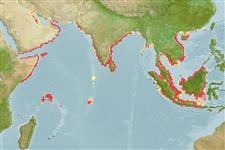Common names from other countries
Environment: milieu / climate zone / depth range / distribution range
Ecologia
; estuarina; intervalo de profundidade 0 - 20 m (Ref. 348). Tropical; 31°N - 9°S, 44°E - 118°E
Indo-Pacific: from northwest Indian Ocean and the Aden Gulf to Indonesia.
Length at first maturity / Tamanho / Peso / Idade
Maturity: Lm ? range ? - ? cm Max length : 6.5 cm SHL macho/indeterminado; (Ref. 348); common length : 5.0 cm SHL macho/indeterminado; (Ref. 348); Idade máx. registada: 3.00 anos (Ref. 8702)
Depth range is based on ecology (Ref. 348); to be replaced wtith a better reference. Primarily marine but also invades backwaters and estuaries (Ref. 105059). Found in protected coastal areas, with shallow subtidal waters (Ref. 348). In muddy and sandy substrates (Ref. 105057) where it burrows (Ref. 105059). Family is known to be suspension feeders, filtering planktonic algae and organic matter from the water (Ref. 348).
Life cycle and mating behavior
Maturidade | Reprodução | Desova | Ovos | Fecundidade | Larvas
Members of the class Bivalvia are mostly gonochoric, some are protandric hermaphrodites. Life cycle: Embryos develop into free-swimming trocophore larvae, succeeded by the bivalve veliger, resembling a miniature clam.
Poutiers, J.M. 1998. (Ref. 348)
Status na Lista Vermelha da IUCN (Ref. 130435)
Status no CITES (Ref. 108899)
Not Evaluated
Not Evaluated
Perigo para os humanos
Harmless
Uso pelos humanos
| FishSource |
Ferramentas
Mais informação
Idade/TamanhoCrescimentoComprimento-pesoComprimento-comprimentoMorfologiaLarvasAbundância
Fontes da internet
Estimates based on models
Preferred temperature
(Ref.
115969): 26.6 - 29.3, mean 28.6 (based on 942 cells).
Vulnerabilidade
Low vulnerability (10 of 100).
